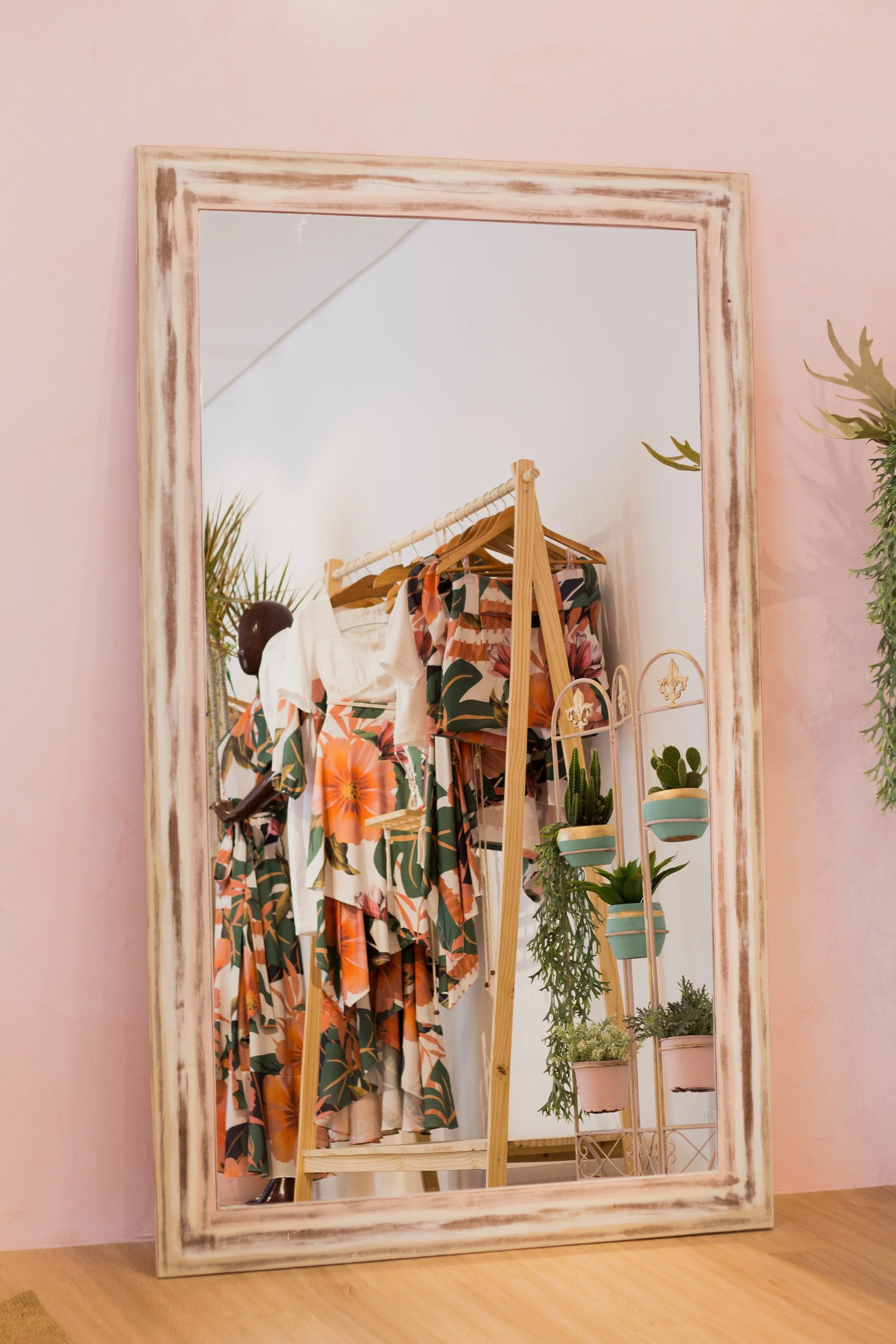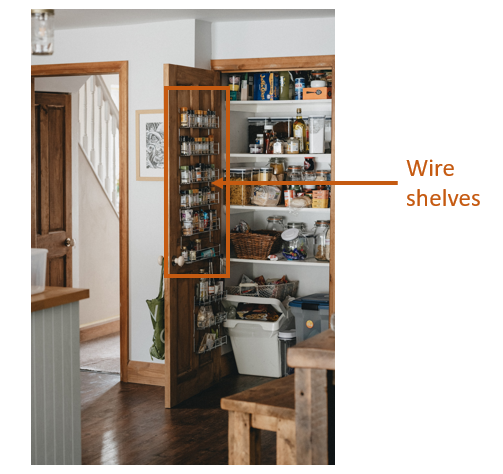Ah, the small house… It’s often described as charming, cozy and quaint. But what you don’t hear it described as roomy, accommodating or versatile. That’s because unlike larger homes with space to spread out and grow, smaller homes are finite, and you have to work with what you’ve got.
Source: Francesca Tosolini, Unsplash
There’s no “bonus” room that lacks definition, or a great room in addition to the family room and living room. Nope, the small house is purposeful. Bedroom(s), kitchen, living, and bath are all exactly what they are intended to be with little wiggle room for any other purpose.
However, unlike big houses where there is sometimes too much space, you can create extra space and the illusion of extra space in a small house with creative hacks.
In this post you’ll learn:
• How to purposefully and efficiently “borrow spaces.”
• How to repurpose everyday items.
• How to use mirrors to trick your senses into thinking there’s more room than what meets the eye.
If you’re in need of more space and an addition on the house isn’t in the cards, then you’re going to love 11 amazing hacks to create space you didn’t know you had!
Declutter Duplicate Items
This first “hack” is more of a procedure to free up space. Decluttering makes the remaining hacks easier to achieve. I include it because without being mindful of unnecessary clutter, you’re just moving stuff around and not getting any extra space.
So, the surefire first place to start finding more room is my ruthlessly declutter duplicate items. I am so guilty of keeping multiples in my own home. My favorite spot to keep too many things is in the kitchen.
I have a full drawer and cabinet filled with spatulas, slotted spoons, ladles, and pretty much every type of stirring tool you can think of. Do I need 15 ladles? Absolutely not. I put this out there because it’s good to acknowledge the items that you know are excessive. I mean, I am not a chef. I don’t cook elaborate means often and it is not inconvenient for me to have 2 ladles for soup instead of 15…
I also horde coffee mugs. They are all the same and I have around 20 of them… I am a single person and I have no need for 20 coffee mugs. I like to have mugs on hand for when company comes and said company most often involves 1 to 2 people. That means I still have way too many mugs for any average day.
Source cottonbro, Pexels
Decluttering duplicates can free up a ton of space. Take an inventory of what you have in every room. Be brutal and really ask yourself, is this necessary? If the answer is no, let it go!
2. Use Vertical Space
Using the height of rooms is an epic way to get more space. Every house has height, even if you live in small home, there’s usually 7’ or more of space to play with.
• Consider a tall freestanding cabinet in the bathroom.
Source Ikea
• Install adjustable shelves in a bedroom closet or hall closet.
Source Ikea
• Hang floating shelves in any room for vertical display.
Source Ikea
Go on the hunt for those spaces that you don’t usually consider. Maybe you have a small pantry in the kitchen and it doesn’t quite utilize the entire height of the space. Maybe there’s items piled on top of items when you could install a few more shelves for more efficient use of the space.
Tip: My rule of thumb for pantry storage is, keep items that you use often between waist and eye level so they are easy to see and grab when you need them. The things you use less often go up higher or lower. This practice totally eliminates hunting for the toaster or mixer in a jungle of miscellaneous appliances.
Source Annie Splatt, Unsplash
Kitchen cabinets are another spot that can usually do with a purge and reorganization. Check out your canned foods cupboard, it’s probably stocked with expired foods because you can’t see what’s shoved in the back.
Get rid of expired cans and install some risers so you can see exactly what you have, at-a-glance. Yes, they will take up space that could be used for more canned goods, but are you really going to need 8 cans of creamed corn at any one time? The risers will keep you organized far more efficiently than stacks of cans that only show the front layer. Another way to think about it is, you’ll always be able to see what you need to replenish quickly which will make writing out the grocery list fast and easy.
Source Alex Voulgaris, Unsplash
Using the height of a room will always make the room feel larger and having tall items makes a space more interesting as well. When everything isn’t the same level, you get a much more interesting composition and layout.
3. Store Clutter in Baskets and Boxes
I love to use open shelves or cubbies in small homes. You can find so many options: some are tall, some are short. Some run horizontal and low, some vertical and tall… You get the picture.
Source Ikea
These storage and display options are great for showing off your treasures, but they also work well for housing baskets and decorative boxes filled with stuff you need but don’t necessarily want on display. Things like power cords, internet routers, toys, craft supplies, and tools.
You know they’re right at hand when needed, but they aren’t taking up visual space and making the room feel crowded and cluttered.
Tip: Plan out storage purchases: not all baskets, boxes or bins will fit in the spaces you have available. Measure the shelf or cubby before you go to the store. Keep those measurements in your notes app on your phone so you always have them with you. Also, take a picture of the shelving unit so you have a clear idea how many spots you need to fill with boxes or baskets.
Source Ikea
4. Add Mirrors
If you want to visually expand your space, add in mirrors to reflect the space you already have. Mirrors on closet doors can make a small bedroom feel larger.
Source Ikea
A decorative mirror in a small living room can reflect light from an adjacent window.
Tip: Some rooms have off center windows. This is common in smaller homes. If you have a off center window, you can balance that window on the opposite side of the wall with a same sized mirror. This hack works best when you treat the mirror like the window and install the same window treatments over the mirror as the window itself. This way you can place furniture in between the mirror and window and it will look like there’s symmetry that isn’t really there.
Place mirrors:
• Perpendicular to windows to draw in the light form outside.
• Install large mirrors in small bathrooms to make the room feel larger.
Source Freshome
• Place leaner mirror in narrow spaces like a hallway to make the space feel larger.
Source Sidnei Maia, Pexels
5. Use Space on the Back of Doors:
shallow wire baskets , wire pantry shelves, a shoe holder that can hold hats, gloves, mittens, belts, scarves.
Source Annie Splatt, Unsplash
The back of a closet door or pantry door is prime real estate for corralling items like brooms and dust pans.
It’s a great spot to stall a spice rack or wire shelving for small items like dryer sheets or cleaning sprays and dust rags. They’ll be there at hand when you need them but, you can close the door and hide them away.
Source Blue Style Blog
Install a command center on the back of the door for things like bulletin boards, chalk boards, white boards, and shallow cubbies for organizing mail or homework.
You can customize the command center to whatever suites your needs. Use it as a communication center to write down notes or tasks that need attention. Keep track of the grocery list and schedules for events and happenings. When everything is recorded in the same place, everybody is on the same page.
Source cottonbro, Pexels
6. Use Open Back Shelving and Etageres
when you can see the wall behind shelving, it visually opens the space. I love using ladder shelves or etageres in small entryways or foyers. They are great because they offer a place to display accessories but because they’re open, you resist the temptation to overload them. A few carefully chosen things on an open shelf make all the difference in a small space.
Source Ikea, Nick Hillier - Unsplash
Conversely, a closed shelf that’s boxy and solid just invites clutter. We naturally think that it should be loaded with books, candles, clutter etc., because we can’t see through it. When shelving is overloaded it immediately makes a space feel smaller and congested.
I love books and I like to decorate with my books. Open shelves invite you to get creative with the placement of books. I’m a fan of stacking 3 large books and placing accessories on top to create a interesting arrangement. You don’t have to line books up vertically, spines facing out, to store them. Your small home is not a library.
7. Use Transparent Accent Furniture
When you place see through furniture in a small space, you get all the functionality of horizontal surfaces but none of the visual clutter.
Clear materials like lucite and acrylic can be made into transparent furniture that is still strong and durable, but completely see through.
Source Wayfair
Items like nesting tables, end tables, console tables, and cocktail tables can be made from this transparent material.
Need bedside tables in a small bedroom but don’t want to congest the space? Place a couple of these clear tables on each side of the bed to keep the room feeling open but giving you a place to put your phone and other bedside necessities.
Source Wayfair
Tip: Is your small dining space feeling too cluttered? Bring in transparent chairs to add functionality and keep the space feeling open and airy.
Source Ikea
8. Corner Shelves
I love a good corner shelf. They can be installed beside a bank of upper cabinets in the kitchen or placed next to a front door to dress up the space and make it a bit more functional with storage baskets or decorative boxes.
Source Ikea
Corner shelves allow you to utilize space that would otherwise be wasted. They provide a wonderful opportunity to add height to a room without necessarily taking up floor space.
A corner shelf can enhance a room by allowing you to have a place to put small collections of accessories.
You may want to put a candle on a corner shelf to bring a bit of ambient light to a dark corner.
A corner shelf in a laundry room or home office can hold items that you need for working in those spaces.
9. Pegboards
Pegboards, the old stand by for garage organization! Pegboards aren’t just for holding tools and gizmos in the workshop or garage. They are a phenomenally useful for keeping any room organized.
There’s so many options on the market and they’re also a great do-it-yourself project if you’re handy.
You can customize the storage of a pegboard system to totally suit your needs. You can have large pegs for placing shelving anywhere you need it. You can install hooks to hold small buckets filled with markers, crayons, pencils, etc. in a craft spot or toy corner.
Source Wayfair
You can hang the tools you need for any room in the house from a peg system:
• Make up brushes by a vanity.
• Cleaning equipment in a basement or mud room.
• Pots, pans and utensils in the kitchen.
10. Empty Suitcases
Unless you’re a frequent traveler, your suitcases are probably sitting empty and taking up valuable space in your closet, am I right?
Source Wayfair
Why not put them to go use and store off season clothes and shoes in them instead of always trying to cram your entire collection of cloths in your small closet?
Removing the items that you won’t need for many months gives you a chance to really showcase and access what you do need for the season you’re in. It will help you capture more useful space for hanging items and free up space for shelves or a closet system you didn’t know you could have…
Source: Arnel Hasanovic
I guarantee you’ll have more room for things like handbags, blankets, bedding and shoes when half of your seasonal wardrobe is stored away in suitcases.
Tip: Stack 3 vintage suitcases on top of one another to create a small end table. They’re amazing hide away storage and you get a surface to place things on next to a chair or sofa.
11. Tension Rods
Many small houses have awkward corners that are not deep enough for shelving but are deep enough to store small things.
A fantastic hack is to install tension rods or dowels in the space to display and store high heels. If you have a shoe obsession and you hate to pile your expensive shoes in the bottom of the closet where they could potentially get damaged, give this hack a try. You’ll be able to showcase your favorite pairs and they will be safely out of the way.
Source Pinterest, Lifebuzz
Another great use of this space is installing a blanket ladder. Instead of a freestanding option, you can hang dowels secured with brackets or cups on the sides. Then just hang up your blankets. This is especially helpful if your extra blankets and bedding are stored in drawers or in the closet. Put that space to better use and install a tension rod or dowel ladder in a “useless” corner.
There you have it, 11 amazing hacks to create space you didn’t know you had!
1. Declutter Duplicate Items
2. Use Vertical Space
3. Store Clutter in Baskets and Boxes
4. Add Mirrors
5. Use Space on the Back of Doors:
6. Use Open Back Shelving and Etageres
7. Use Transparent Accent Furniture
8. Corner shelves
9. Peg boards
10. Empty Suitcases:
11. Tension rods
Getting creative with storage and multi-functional pieces will help you create tons of space.
I’d love to hear what you do in your small house to create more space and organization. Leave me a comment below to tell me a few of your hacks.
Don’t forget to subscribe to be the first to know when I post my next blog on small homes, small space living, decorating and design each week. There’s a couple free resources for you right below when you sign up today.
Thanks so much for stopping by and remember, keep your dreams big for your small house!
Join The Fun!
If you enjoyed this post and you want to keep seeing my weekly blog, the best way to do that is to subscribe.
You can subscribe by downloading my 11 Secrets Only Designers Know to Make Your Space Rock. If you’re curious about how decorators and designers make a home look magazine ready, you’ll love taking a gander at these 11 secrets. You’ll learn how to style your room from the floor up and it will work for ANY space you have.
I write about small space design and decorating, sustainable furniture options, positive self care and a variety of do-it-yourself home décor.
I’d love to connect with you!
“This man is a plant shaman. He not only designs beautiful rooms, he’s got a green thumb that works like magic! My peace palm never looked better.”
“Michael Helped me to get my home office in magazine ready form. Thank you a million times for helping me figure this room out. It’s now my favorite room!”
Michael is Principal designer and blogger at Michael Helwig Interiors in beautiful Buffalo, New York. Since 2011, he’s a space planning expert, offering online interior e-design services for folks living in small homes, or for those with awkward and tricky layouts. He’s a frequent expert contributor to many National media publications and news outlets on topics related to decorating, interior design, diy projects, and more. Michael happily shares his experience to help folks avoid expensive mistakes and decorating disappointments. You can follow him on Pinterest, Instagram and Facebook @interiorsmh.





































